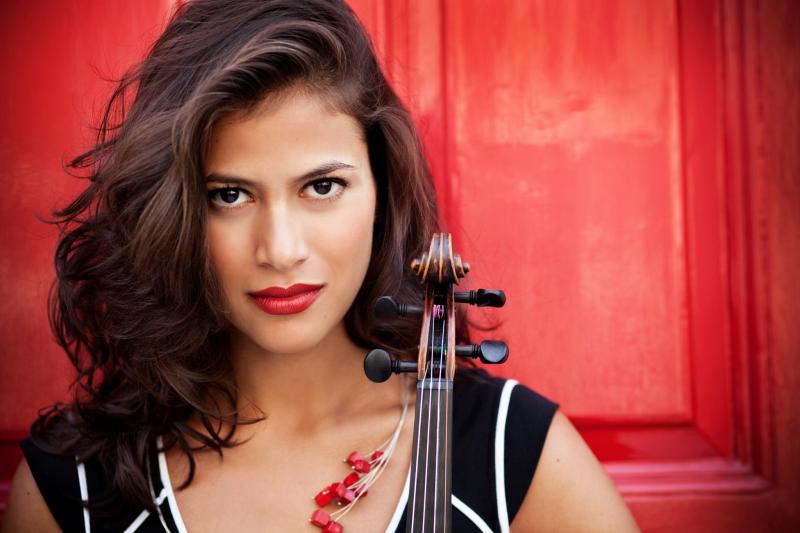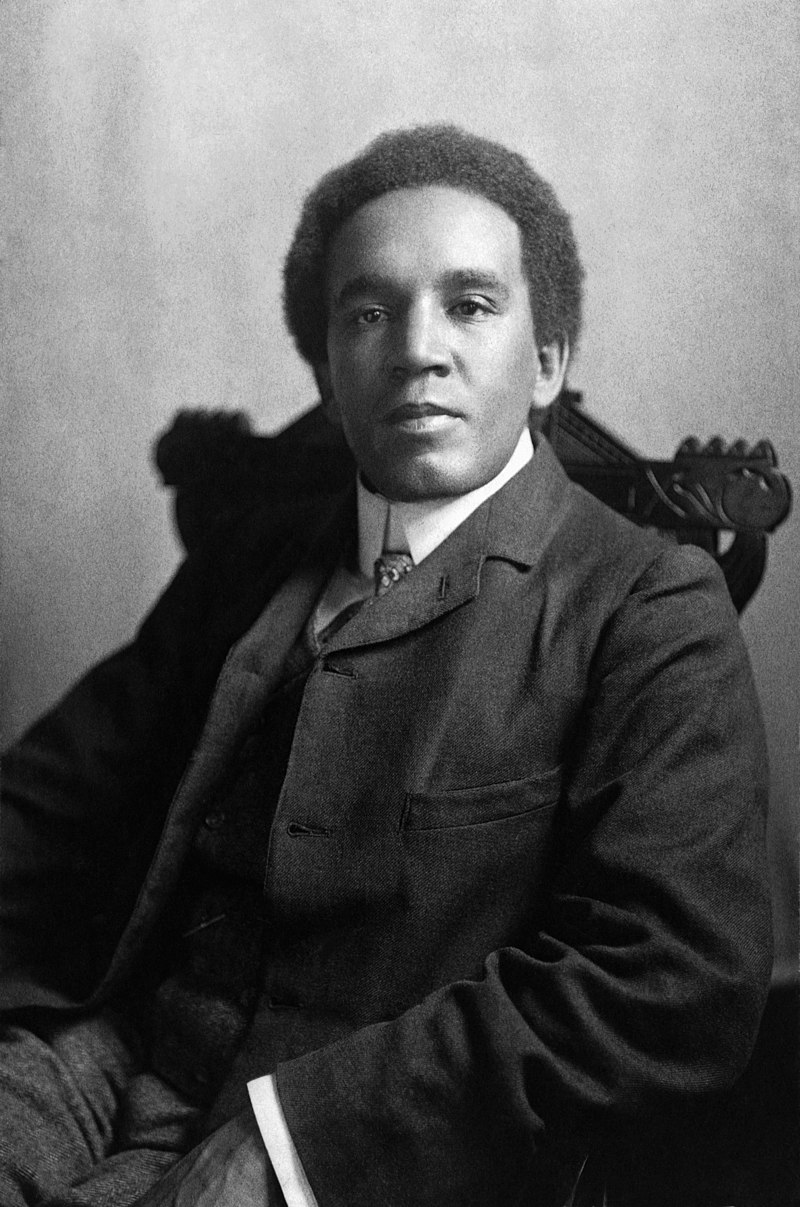Urioste, Chineke! Orchestra, Edusei, QEH review – a precious gem catches the light at last | reviews, news & interviews
Urioste, Chineke! Orchestra, Edusei, QEH review – a precious gem catches the light at last
Urioste, Chineke! Orchestra, Edusei, QEH review – a precious gem catches the light at last
Coleridge-Taylor's Violin Concerto shines ready for this idealistic orchestra's tour

The Chineke! Orchestra, founded by double-bassist Chi-chi Nwanoku as the first majority BME orchestra in the UK, is heading off this week on a substantial European tour, which began last night at the Queen Elizabeth Hall.
This 1912 work is exquisitely beautiful. It is proud, upbeat, tender, idealistic, memorable and deceptively tricky. Comparisons to Dvorák tend to stem from the composer’s employment of spiritual-like themes and a light-footed, syncopated finale, but really the similarity stops there: Coleridge-Taylor had a strong individual voice that perhaps reached its apex in this, one of his last works. Half-African, half-British, much encouraged by his teacher Charles Stanford and admired by Elgar, who gave him a helping hand by recommending him for a commission, he has become something of a figurehead composer for Chineke! and with good reason.
 Aged only 37, he collapsed on West Croydon station and died soon afterwards of pneumonia, largely brought on by overwork. The Violin Concerto had contributed to this: it was to be premiered in the US by the violinist Maud Powell, but the orchestral parts were lost at sea (possibly apocryphal legend has it that they sank on the Titanic) and the unfortunate composer had to recreate them himself at high speed. Although his cantata Hiawatha’s Wedding Feast was one of the most popular choral works in Edwardian Britain, he had sold it to a publisher for next to nothing and never benefited financially from its success. He did not live to hear the concerto’s UK premere. Witnesses reported that in a delirious fever on his deathbed he imagined conducting it.
Aged only 37, he collapsed on West Croydon station and died soon afterwards of pneumonia, largely brought on by overwork. The Violin Concerto had contributed to this: it was to be premiered in the US by the violinist Maud Powell, but the orchestral parts were lost at sea (possibly apocryphal legend has it that they sank on the Titanic) and the unfortunate composer had to recreate them himself at high speed. Although his cantata Hiawatha’s Wedding Feast was one of the most popular choral works in Edwardian Britain, he had sold it to a publisher for next to nothing and never benefited financially from its success. He did not live to hear the concerto’s UK premere. Witnesses reported that in a delirious fever on his deathbed he imagined conducting it.
The American violinist Elena Urioste brought the work everything it deserves: a rich, glowing tone, rhythmic panache, shedloads of charisma and a tenderness that cradled the slow movement as if it were the most precious jewel in the world, which I think it actually may be. Conductor Kevin John Edusei - blessed with an authoritative presence plus huge and expressive hands - was a sensitive and sensible accompanist, expertly fielding Coleridge-Taylor’s numerous curveball gear-changes and attentive not only to clarity of detail but also the orchestral sound’s potential to form a halo around the soaring violin line. It is high time this gorgeous concerto was heard more widely. Perhaps Chineke!’s tour will help to spread the word at last.  Edusei offered decisive, energetic interpretations of the Weber and Brahms, letting no grass grow under his feet: tempi were lively and the rhythmic pulse ebbed, flowed and breathed easily. Chineke!’s membership varies from concert to concert: musicians come from all over the world to take part - some are soloists, chamber musicians or hold orchestral posts and a few are still studying. Last night the ensemble still needed to settle in a little bit, but no doubt it will during the tour. It is a smallish gathering this time (only five cellos, for example) and the Brahms could perhaps have done with a meatier tone from some of the upper strings. Nevertheless, the South African violinist Samson Diamond is a stylish leader, the double-basses led by Nwanoku bring a lovely solid grounding to the texture, and with the Oberon Overture and Brahms’s Second it was a big evening for the horn players, who rose splendidly to the occasion. And every player has a fascinating story of their own. As these ambassadors for musical inclusivity set off on the road, the message they carry has never been more important.
Edusei offered decisive, energetic interpretations of the Weber and Brahms, letting no grass grow under his feet: tempi were lively and the rhythmic pulse ebbed, flowed and breathed easily. Chineke!’s membership varies from concert to concert: musicians come from all over the world to take part - some are soloists, chamber musicians or hold orchestral posts and a few are still studying. Last night the ensemble still needed to settle in a little bit, but no doubt it will during the tour. It is a smallish gathering this time (only five cellos, for example) and the Brahms could perhaps have done with a meatier tone from some of the upper strings. Nevertheless, the South African violinist Samson Diamond is a stylish leader, the double-basses led by Nwanoku bring a lovely solid grounding to the texture, and with the Oberon Overture and Brahms’s Second it was a big evening for the horn players, who rose splendidly to the occasion. And every player has a fascinating story of their own. As these ambassadors for musical inclusivity set off on the road, the message they carry has never been more important.
rating
Explore topics
Share this article
The future of Arts Journalism
You can stop theartsdesk.com closing!
We urgently need financing to survive. Our fundraising drive has thus far raised £49,000 but we need to reach £100,000 or we will be forced to close. Please contribute here: https://gofund.me/c3f6033d
And if you can forward this information to anyone who might assist, we’d be grateful.

Subscribe to theartsdesk.com
Thank you for continuing to read our work on theartsdesk.com. For unlimited access to every article in its entirety, including our archive of more than 15,000 pieces, we're asking for £5 per month or £40 per year. We feel it's a very good deal, and hope you do too.
To take a subscription now simply click here.
And if you're looking for that extra gift for a friend or family member, why not treat them to a theartsdesk.com gift subscription?
more Classical music
 Monteverdi Choir, ORR, Heras-Casado, St Martin-in-the-Fields review - flames of joy and sorrow
First-rate soloists, choir and orchestra unite in a blazing Mozart Requiem
Monteverdi Choir, ORR, Heras-Casado, St Martin-in-the-Fields review - flames of joy and sorrow
First-rate soloists, choir and orchestra unite in a blazing Mozart Requiem
 Cho, LSO, Pappano, Barbican review - finely-focused stormy weather
Chameleonic Seong-Jin Cho is a match for the fine-tuning of the LSO’s Chief Conductor
Cho, LSO, Pappano, Barbican review - finely-focused stormy weather
Chameleonic Seong-Jin Cho is a match for the fine-tuning of the LSO’s Chief Conductor
 Classical CDs: Shrouds, silhouettes and superstition
Cello concertos, choral collections and a stunning tribute to a contemporary giant
Classical CDs: Shrouds, silhouettes and superstition
Cello concertos, choral collections and a stunning tribute to a contemporary giant
 Appl, Levickis, Wigmore Hall review - fun to the fore in cabaret and show songs
A relaxed evening of light-hearted fare, with the accordion offering unusual colours
Appl, Levickis, Wigmore Hall review - fun to the fore in cabaret and show songs
A relaxed evening of light-hearted fare, with the accordion offering unusual colours
 Lammermuir Festival 2025, Part 2 review - from the soaringly sublime to the zoologically ridiculous
Bigger than ever, and the quality remains astonishingly high
Lammermuir Festival 2025, Part 2 review - from the soaringly sublime to the zoologically ridiculous
Bigger than ever, and the quality remains astonishingly high
 BBC Proms: Ehnes, Sinfonia of London, Wilson review - aspects of love
Sensuous Ravel, and bittersweet Bernstein, on an amorous evening
BBC Proms: Ehnes, Sinfonia of London, Wilson review - aspects of love
Sensuous Ravel, and bittersweet Bernstein, on an amorous evening
 Presteigne Festival 2025 review - new music is centre stage in the Welsh Marches
Music by 30 living composers, with Eleanor Alberga topping the bill
Presteigne Festival 2025 review - new music is centre stage in the Welsh Marches
Music by 30 living composers, with Eleanor Alberga topping the bill
 Lammermuir Festival 2025 review - music with soul from the heart of East Lothian
Baroque splendour, and chamber-ensemble drama, amid history-haunted lands
Lammermuir Festival 2025 review - music with soul from the heart of East Lothian
Baroque splendour, and chamber-ensemble drama, amid history-haunted lands
 BBC Proms: Steinbacher, RPO, Petrenko / Sternath, BBCSO, Oramo review - double-bill mixed bag
Young pianist shines in Grieg but Bliss’s portentous cantata disappoints
BBC Proms: Steinbacher, RPO, Petrenko / Sternath, BBCSO, Oramo review - double-bill mixed bag
Young pianist shines in Grieg but Bliss’s portentous cantata disappoints
 theartsdesk at the Lahti Sibelius Festival - early epics by the Finnish master in context
Finnish heroes meet their Austro-German counterparts in breathtaking interpretations
theartsdesk at the Lahti Sibelius Festival - early epics by the Finnish master in context
Finnish heroes meet their Austro-German counterparts in breathtaking interpretations
 Classical CDs: Sleigh rides, pancakes and cigars
Two big boxes, plus new music for brass and a pair of clarinet concertos
Classical CDs: Sleigh rides, pancakes and cigars
Two big boxes, plus new music for brass and a pair of clarinet concertos
 Waley-Cohen, Manchester Camerata, Pether, Whitworth Art Gallery, Manchester review - premiere of no ordinary violin concerto
Images of maternal care inspired by Hepworth and played in a gallery setting
Waley-Cohen, Manchester Camerata, Pether, Whitworth Art Gallery, Manchester review - premiere of no ordinary violin concerto
Images of maternal care inspired by Hepworth and played in a gallery setting

Add comment